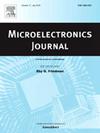Analyzing negative differential resistance and capacitive effects in SiOx-based resistive switching devices for security applications
IF 1.9
3区 工程技术
Q3 ENGINEERING, ELECTRICAL & ELECTRONIC
引用次数: 0
Abstract
In this work, we analyze the negative differential resistance and capacitive effects in SiOx-based resistive switching devices. The cause of the negative differential effect has been investigated through the study of the switching mechanism in the devices. It has been observed that there is a combination of trap-controlled space charge limited conduction and trap-assisted Poole-Frenkel effect in the devices. Trapping and de-trapping of injected electrons in the defects within the silica structure causes the negative differential resistance effect. This characteristic feature can be employed to design chaotic circuits for security applications. In addition, the high electric field developed in the device compared to the applied field during the change of bias voltage from ±5V–0V, results in a capacitor discharge-like effect. This work will be a step forward in achieving the global Sustainable Development Goal of Peace, Justice, and Strong Institutions (SDG 16).
分析安全应用中基于氧化硅的电阻开关器件的负差分电阻和电容效应
在这项研究中,我们分析了基于氧化硅的电阻开关器件中的负差分电阻和电容效应。通过研究器件中的开关机制,我们找到了负差分效应的原因。研究发现,器件中存在阱控制的空间电荷限导和阱辅助的普尔-弗伦克尔效应。注入电子在二氧化硅结构缺陷中的捕获和去捕获导致了负微分电阻效应。这一特性可用于设计安全应用的混沌电路。此外,在偏置电压从 ±5V 到 0V 的变化过程中,器件内形成的高电场与外加电场相比,会产生类似电容器放电的效果。这项工作将在实现全球可持续发展目标 "和平、公正和强有力的机构"(可持续发展目标 16)方面向前迈出一步。
本文章由计算机程序翻译,如有差异,请以英文原文为准。
求助全文
约1分钟内获得全文
求助全文
来源期刊

Microelectronics Journal
工程技术-工程:电子与电气
CiteScore
4.00
自引率
27.30%
发文量
222
审稿时长
43 days
期刊介绍:
Published since 1969, the Microelectronics Journal is an international forum for the dissemination of research and applications of microelectronic systems, circuits, and emerging technologies. Papers published in the Microelectronics Journal have undergone peer review to ensure originality, relevance, and timeliness. The journal thus provides a worldwide, regular, and comprehensive update on microelectronic circuits and systems.
The Microelectronics Journal invites papers describing significant research and applications in all of the areas listed below. Comprehensive review/survey papers covering recent developments will also be considered. The Microelectronics Journal covers circuits and systems. This topic includes but is not limited to: Analog, digital, mixed, and RF circuits and related design methodologies; Logic, architectural, and system level synthesis; Testing, design for testability, built-in self-test; Area, power, and thermal analysis and design; Mixed-domain simulation and design; Embedded systems; Non-von Neumann computing and related technologies and circuits; Design and test of high complexity systems integration; SoC, NoC, SIP, and NIP design and test; 3-D integration design and analysis; Emerging device technologies and circuits, such as FinFETs, SETs, spintronics, SFQ, MTJ, etc.
Application aspects such as signal and image processing including circuits for cryptography, sensors, and actuators including sensor networks, reliability and quality issues, and economic models are also welcome.
 求助内容:
求助内容: 应助结果提醒方式:
应助结果提醒方式:


